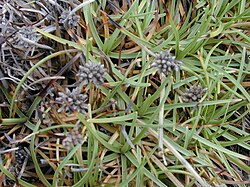| Tropical fimbry | |
|---|---|
 | |
| Scientific classification | |
| Kingdom: | Plantae |
| Clade: | Tracheophytes |
| Clade: | Angiosperms |
| Clade: | Monocots |
| Clade: | Commelinids |
| Order: | Poales |
| Family: | Cyperaceae |
| Genus: | Fimbristylis |
| Species: | F. cymosa |
| Binomial name | |
| Fimbristylis cymosa | |
| Subspecies [2] | |
| |
| Synonyms [2] | |
| |
Fimbristylis cymosa, commonly known as tropical fimbry, or St. John's sedge, [3] is a sedge of the family Cyperaceae. It has a wide distribution in tropical and subtropical regions of the Americas, sub-Saharan Africa, Asia, Australasia, and the Pacific. [2]
The rhizomatous perennial grass-like or herb sedge typically grows to a height of 0.25 to 0.8 metres (1 to 3 ft). It blooms between February and September and produces brown flowers. [4]
In Western Australia it is found near the coast, on dunes and behind mangroves in the Kimberley region where it grows in sandy-clay alluvium around basalt or sandstone rocks. [4]
